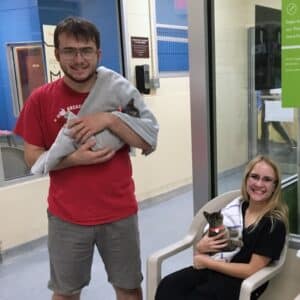
Think of all the things we could discuss
If we could walk with the animals, talk with the animals,
Grunt and squeak and squawk with the animals,
And they could squeak and squawk and speak and talk to us.
- Doolittle theme
Beacon College anthrozoology students began channeling their inner Dr. Doolittle last month thanks to a new partnership between the college and the Lake County Animal Shelter aimed at giving students in-depth, hands-on exposure to shelter management.
The partnership benefits the college’s “Animal Shelter Operations & Management” course, offered, for the third time, this semester. In the past, Beacon worked with multiple animal shelters that offered workshops during field trips. That nomadic approach, however, left the college and students “missing a connection and the ability to dive in-depth into several aspects of managing an animal shelter,” said Dr. Brian Ogle, chair of the college’s anthrozoology department.
That changes with this new collaboration.
Ogle said the partnership allows the college to expand offerings related to companion animals. Now, students can witness theory and research applied in real-life animal shelter operations during once-weekly visits.
At the suggestion of Lake County District 5 Commissioner Josh Blake, the Beacon anthrozoology team approached Boylston last fall to launch the partnership for the spring 2020 semester.
Last month, the Lake County Commission approved the partnership.
Beacon anthrozoology students now enjoy an “internship-style” style work experience in the shelter’s daily activities, said Whitney Boylston, Director of the Office of Animal Services at the Lake County Animal Shelter in Tavares, Fla. Students focus on areas including shelter management, public safety and health, live release coordination, adoption counseling and placement, and marketing.
“We are part of a rapidly growing national movement to embrace lifesaving and compassionate decision-making in animal sheltering,” she said. “As more communities are focusing efforts on saving lives, there is a growing need for an educated, experienced, dedicated workforce in animal welfare and public sheltering. We hope that our relationship with Beacon College will inspire students to explore careers in the field.”
The arrangement grants students an interactive window by which to view the full scope of shelter management — happy and sad. That includes the heartbreak of un-adoptable animals, money issues, space, family reunions, new pet adoptions and more, said Michelle Szydlowski, the lead anthrozoology instructor for the course.
Students must prepare outside work ahead of their shelter time that focuses on applying ideas and theory.
For example, students might develop a campaign to aid the adoption of a long-term shelter resident. Or they might devise a campaign for a special supply drive fueled by their intimate understanding of the shelter’s needs.
“They will learn not only from their instructor, but also from shelter staff,” Ogle said. “This provides students with the ability to go in-depth into animal shelter operations and to gain valuable field experiences.”
The partnership, he added, “mirrors the other unique offerings in different focus areas of the anthrozoology program. For example, our zoo science students have a very similar course in which they are at ZooTampa one full day a week. They learn from the instructor and engage with the staff in workshops, special tours, and all assignments are designed to demonstrate real-world application.”
In 2016, Beacon College, a nonprofit liberal arts school and America’s first accredited baccalaureate institution to educate primarily neurodiverse students, became the second American undergraduate institution to offer a major in anthrozoology.
Now, four year later, Ogle said the shelter partnership is another important building block.
“Our goal,” he Ogle, “is to continue to grow the partnership and to offer experiences for our students all year. In addition, our goal is to continue to find ways to help the shelter and the animals served by the facility.”